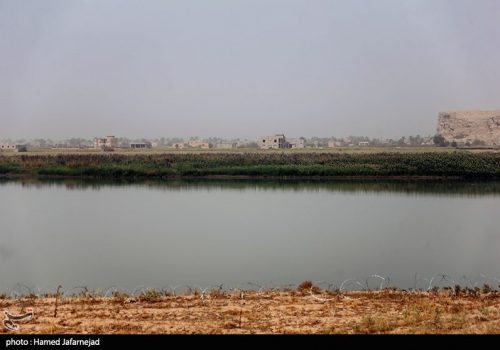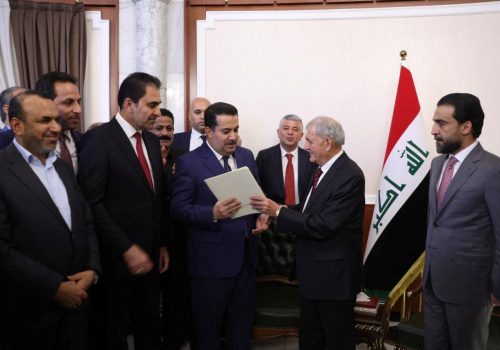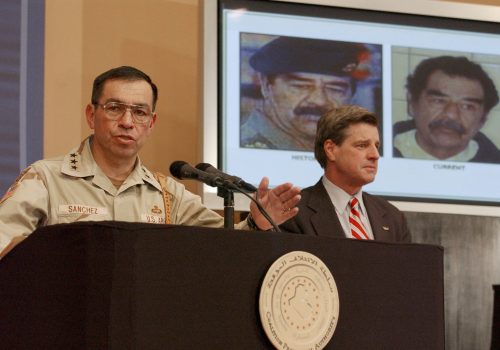The US needs to be proactive in order to break its escalatory cycle with Iran
Here we go again. On March 23, Iran-backed Iraqi militias launched a drone attack that killed an American contractor and wounded another, as well as twenty-four US military personnel. The attack feels very much like a repeat of the one in December 2019, which also killed a US contractor and led to an escalatory cycle, where a US strike killed Islamic Revolutionary Guards Corps (IRGC) Quds Force Commander, Qasem Soleimani, and Kataib Hezbollah leader, Abu Mahdi al-Muhandis. The cycle ended when Iran fired missiles at US forces on the Iraqi base at Ain al-Asad. The missiles overshot the base, causing no casualties, thereby mitigating the need for a US response.
In response to the more recent attacks, the United States carried out strikes the next day against IRGC facilities, reportedly killing nineteen people, including three Syrian regime soldiers and sixteen members of Iran-backed militias operating in Syria. On March 25, militants responded with another attack on a base that houses US forces, but there were no casualties.
Iran-backed militias struck again at a base near the Conoco gas field, which caused some material damage, but it didn’t result in any casualties. The United States again responded with strikes and extended a carrier deployment in the Mediterranean Sea as further deterrence. Thus ended, it seems, another escalatory cycle where rockets were fired, drones were launched, and bombs were dropped.
However, the aforementioned tit-for-tat exchanges have not been the only ones. In fact, there have been almost eighty attacks against US forces since 2021. While the United States should respond when Iran and its proxies attack, it is not always clear how to do so in ways that do more good than harm.
In 2020, the US response also provoked widespread anti-US demonstrations that called for the expulsion of US forces and included an attack on the American embassy in Baghdad, forcing the evacuation of most of its staff. On the first anniversary of Soleimani’s death, the embassy was rocketed again, killing an Iraqi soldier guarding it.
This dynamic is the strategic version of a “coddiwomple,” which means to travel purposefully towards a vague destination. Doing so may be fine for certain lifestyles, but it is no way to run foreign policy. Tit-for-tat retaliation against Tehran-sponsored attacks may represent a way forward—it is just not clear to where.
Other strategic options have their own problems
Unfortunately, US options appear limited. The status quo—where the United States engages in a tit-for-tat exchange with Iran and its proxies, hoping the latter eventually gives up before the former does—works against US interests. While the United States overmatches these groups, this fight is taking place in said groups’ backyard, so the stakes are much higher. In fact, a common feature of strong-weak interactions is that the weak power is incentivized to resist—even when demands seem reasonable and costs high—for fear of future demands. Under such conditions, it is more likely that the United States will concede before Iran does. Moreover, Iran knows the United States will not escalate to conventional war, which allows Iran to manage the costs of their continuous provocations.
The United States could attempt to impose costs by non-military means, but so far, these have not had any deterrent effect. The group responsible for the March 24 attack—the Liwa al-Ghaliboun—is closely associated with the Harakat Hezbollah al-Nujaba, which the US State Department has already designated as a terrorist group. Given the overwhelming sanctions already in place against Iran, it is difficult to see how implementing more will fundamentally change the situation.
The United States could also simply not retaliate when these strikes occur and support the Iraqi government’s efforts to control these militias. However, whenever the Iraqi government tries to exert such control, they typically fail—often at significant cost. Even when efforts to contain militias are successful, as they arguably were after Iran-backed parties suffered electoral defeat in 2022, they are able to exploit Iraq’s weak institutions—in this case, the Iraqi Supreme Court—to maintain their grip.
Deterrence depends on two things. First, an adversary must believe its opponent perceives it is better off if it acts on its deterrent threat. Second, an adversary must believe it will be worse off if its opponent does so. Those conditions do not hold in the current dynamic. Iran does not believe the United States will escalate to the point Iran will be worse off than if it did not continue these provocations. Thus, any path forward requires convincing the Iranians that they have crossed that threshold while providing a pathway that is less costly to both sides than the status quo, but which still allows both to pursue their interests. Getting to that point may be difficult, but recent developments may provide some opportunities to change the current dysfunctional dynamic.
The United States needs to be proactive—not reactive
Unlike in the past, the drone strike that killed the American contractor on March 23 was launched into Syria from Iraq. While the Iraqi government has been unable to constrain militia activity inside its borders, it has a strong interest in preventing its territory from being used as a base of operations. This concern is especially acute with Nujaba, which sees itself not just as an Iranian ally, but as part of Iran’s regional efforts to expand its influence.
Given the strong popular reaction to Iranian influence that triggered the October 2019 protests and, perhaps, most importantly, the election results in October 2021, the Iraqi government may be in a position to isolate Nujaba and pressure it to cease cross-border attacks on US forces without generating backlash from the other militias. In fact, other militias may benefit if Nujaba—which broke away from Asa’ib Ahl al-Haq in 2013—was diminished.
As noted above, under current conditions, not responding to attacks on US forces simply encourages more attacks. Thus, as a response such passivity invites escalation as much as a kinetic strike. At the moment, however, US retaliation is reactive, which allows Iran and its proxies to engage on their terms and, thus, manage their costs. While potentially escalatory, it may make sense to be more proactive in engaging militia and IRGC entities and their ability to conduct operations. Such efforts could include kinetic strikes on assets in Syria, where they pose the greatest threat, but should also consist of non-lethal efforts to disrupt regional communications and support systems through other means.
While maintaining a carrier presence in the Mediterranean makes sense in the short term, a longer-term solution could entail a more robust and continuous naval and air presence in the Persian Gulf, which the Iranians do not have an effective response to. While the US is sending additional forces to the region in response to the Iranian seizure of oil tankers, deploying these forces could be more effective if tied to a broader deterrent strategy rather than as an answer to an immediate crisis.
The recent normalization of relations brokered by China, as well as the ongoing Saudi-Iran dialogue hosted by Iraq, depend on regional stability for their success, which is undermined by these continuous escalatory cycles. Thus, it makes sense to enlist support from Saudi Arabia and even Beijing to pressure Iran to cease attacks against US forces. Of course, neither are likely in a mood to assist the United States; however, pointing out the link between normalization and stability is an appeal to their self-interest. To the extent that Iran is interested in relations with Saudi Arabia and China, it may be incentivized to cease attacks.
Taken together, these measures can create space where Iran remains relatively free to exert influence while constrained in the violence it sees fit to employ. It also bolsters US options to retaliate should these efforts fail. This path gives the United States more options to pressure Iran and its proxies while possibly bolstering the Iraqi government’s position relative to the militias. Such an equilibrium may not be ideal, but at least it could lower the temperature and decrease attacks against US forces. If reached, this could buy time for the United States and its partners to further leverage the thawing of Saudi-Iran relations—and Iraq’s role in it—to create better conditions for regional stability.
Dr. C. Anthony Pfaff is a nonresident senior fellow with the Atlantic Council’s Iraq Initiative and the research professor for Strategy, the Military Profession, and Ethics at the Strategic Studies Institute (SSI), US Army War College in Carlisle, PA. The Opinions expressed here are his own and do not necessarily represent those of the US government.
Further reading
Mon, Oct 28, 2019
A highway linking Iraq and Syria becomes an opportunity for Tehran
MENASource By
In the past month, the sands have shifted within the Levant’s political landscape. The United States has recalibrated its official policy in the region, choosing to draw down its special operations forces in northern Syria and thereby introducing a power vacuum in the region. After an offensive and brief ceasefire in northern Syria, Moscow and Ankara […]
Fri, Nov 4, 2022
Iraq has a new government. The United States would benefit from broad engagement with all Iraqi stakeholders.
MENASource By C. Anthony Pfaff
Such an approach will typically yield modest results, but these results can accumulate and place the United States in a better position.
Mon, May 1, 2023
Should history rethink Paul Bremer’s role in the Iraq war?
MENASource By Andrew L. Peek
In the pantheon of Iraq war “villains,” perhaps no single official has been blamed for more disaster than Paul Bremer, the Coalition Provisional Authority leader who ruled Iraq for roughly one year.
Image: Supporters of Hashd al-Shaabi (Popular Mobilization Forces) gather to watch the burning of a large printed image of the U.S. Embassy, to mark the anniversary of the killing of Iranian military commander General Qassem Soleimani and Iraqi militia commander Abu Mahdi al-Muhandis in a U.S. drone attack, in Baghdad, Iraq December 31, 2021. REUTERS/Ahmed Saad


